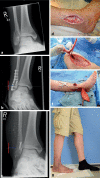[Reconstruction of posttraumatic soft tissue defects of the ankle using free fascial flaps from the anterolateral thigh]
- PMID: 34686888
- PMCID: PMC8533668
- DOI: 10.1007/s00113-021-01100-9
[Reconstruction of posttraumatic soft tissue defects of the ankle using free fascial flaps from the anterolateral thigh]
Abstract
Background: Free fascial flaps from the anterolateral thigh (ALT) were used to reconstruct soft tissue defects after trauma to the ankle. This modification was compared to the conventional fasciocutaneous method.
Material and methods: The defect size, the thickness of the subcutaneous fat layer on the thigh and the extent of the soft tissue covering the ankle were determined retrospectively. The evaluations were compared between fascial (Fo) and fasciocutaneous flaps (Fc). The foot and ankle outcome score (FAOS) was used. Esthetic outcome surveys were carried out.
Results: A total of 18 isolated fractures of the ankle were evaluated. In 94% of the cases a closed soft tissue damage predominated. After fracture fixation using a plate, soft tissue defects with a mean area of 40.4 ± 13.1 cm2 (28-76 cm2) developed. The thickness of the soft tissue covering over the affected malleoli increased significantly in both groups as a result of the flap surgery (4.5 ± 0.7 vs. 21.1 ± 6.4 mm, p < 0.05). A significant difference was found when comparing the body mass index (BMI) between the groups (Fc 26.3 ± 3.4 kg/m2 vs. Fo 30.1 ± 4.2 kg/m2, p < 0.05). For both groups there was a positive correlation (r = 0.843) between the BMI and the thickness of the epifascial fat layer of the thigh. The FOAS survey revealed 75.9 ± 28.9 and 47.9 ± 32.4 points, respectively, for "function in daily life" and "foot and ankle-related quality of life". The esthetic reconstruction result was rated as "acceptable" by 55% and as "good" by 45%.
Discussion: The modified method of a free fascial flap from the ALT can be useful in situations where a bulky flap makes it difficult to fit it into the defect.
Zusammenfassung: HINTERGRUND: Zur Rekonstruktion von Weichteildefekten nach sprunggelenknahen Frakturen wurden freie Faszienlappen aus dem anterolateralen Oberschenkel (ALT) verwendet. Diese Modifikation wurde mit der herkömmlichen fasziokutanen Methode verglichen.
Material und methoden: Defektgröße, Dicke der subkutanen Fettschicht des Oberschenkels und des Weichteilmantels am Sprunggelenk wurden retrospektiv bestimmt. Die Auswertungen wurden zwischen faszialen (Fo) und fasziokutanen Lappen (Fc) verglichen. Der Foot and Ankle Outcome Score (FAOS) wurde verwendet. Umfragen zum ästhetischen Ergebnis wurden durchgeführt.
Ergebnisse: Bei insgesamt 18 Frakturen lag in 94 % ein geschlossener Weichteilschaden vor. Nach Plattenosteosynthese entwickelten sich Weichteildefekte mit einer mittleren Fläche von 40,4 ± 13,1 cm2 (28–76 cm2). Der Weichteilschatten über den betroffenen Malleoli nahm durch die Lappenplastik an Dicke signifikant in beiden Gruppen zu (4,5 ± 0,7 vs. 21,1 ± 6,4 mm, p < 0,05). Es fand sich ein signifikanter Unterschied beim Vergleich des Body-Mass-Index (BMI) zwischen den Gruppen (Fc 26,3 ± 3,4 kg/m2 vs. Fo: 30,1 ± 4,2 kg/m2, p < 0,05). Für beide Gruppen bestand eine positive Korrelation (r = 0,843) zwischen dem BMI und der Dicke des epifaszialen Weichteilmantels am Oberschenkel. Zur „Funktion im täglichen Leben“ und zur „fuß- und knöchelbezogenen Lebensqualität“ ergaben sich in der FOAS-Befragung 75,9 ± 28,9 bzw. 47,9 ± 32,4 Punkte. Rund 55 % haben das ästhetische Rekonstruktionsergebnis als „akzeptabel“ und 45 % als „gut“ bewertet.
Diskussion: Der modifizierte ALT-Faszien-Lappen kann in Situationen sinnvoll sein, wo eine stark auftragende Fett-Haut-Schicht die Einpassung des Lappens in den Defekt erschwert.
Keywords: ALT; Free tissue transfer; Microsurgery; Surgical side infection; Wound.
© 2021. Springer Medizin Verlag GmbH, ein Teil von Springer Nature.
References
Publication types
MeSH terms
LinkOut - more resources
Full Text Sources
Medical






